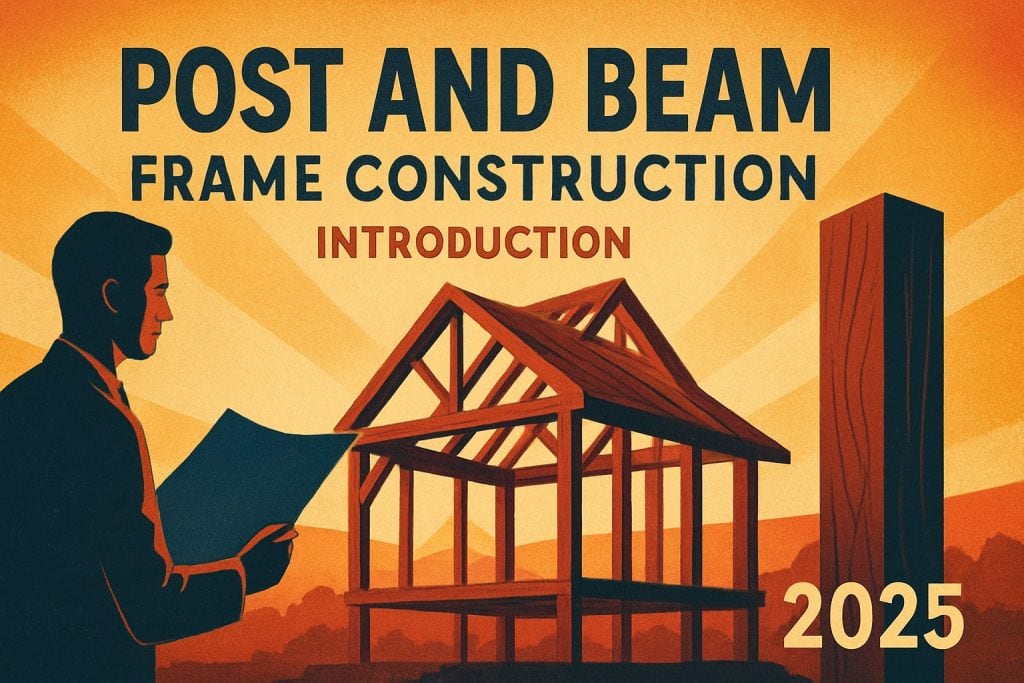The timeless charm of post and beam frame construction is captivating homeowners and architects alike, with a marked revival in both residential and commercial projects for 2025. This expert guide explores every facet of post and beam frame construction, from traditional building methods to innovative trends shaping the industry today. Whether you are planning a bespoke home or a dynamic workspace, you will find detailed insights into construction principles, material selection, design flexibility, cost considerations, and comparisons with alternative building systems. Discover how to combine architectural beauty, robust engineering, and sustainability in your next project.
Understanding Post and Beam Frame Construction
Post and beam frame construction is rooted in centuries of building heritage, yet it remains at the forefront of innovative architecture today. To appreciate its resurgence and practical value, it is essential to explore its historical context, core principles, comparison with timber framing, and broad range of applications.

Historical Background and Evolution
The origins of post and beam frame construction can be traced back more than 4,000 years, with evidence in ancient civilisations across Europe and Asia. Early methods relied on large, hand-hewn timbers, joined together to form the skeletons of homes and communal buildings. Over time, these techniques spread, influencing the development of traditional timber framing in the UK.
By the medieval period, post and beam frame construction had become a defining feature of barns, halls, and rural dwellings. The 20th century saw a shift from pure timber structures to hybrid approaches, combining steel with wood for added strength and flexibility. Notable examples include England’s historic market halls and modern commercial pavilions, both showcasing the enduring appeal and adaptability of post and beam frame construction.
Core Principles and Structural Components
At its heart, post and beam frame construction relies on a system of vertical posts and horizontal beams. Posts are typically spaced between 23 and 47 inches apart, depending on the building’s scale and load requirements. The main structural elements include posts, beams, decking, and the foundation, all working together to transfer weight safely to the ground.
Modern methods make use of metal fasteners, bolts, and steel brackets to assemble the frame quickly and securely. This approach allows for expansive open-plan interiors, as minimal internal walls are required for support. The result is a versatile framework that provides both stability and design freedom.
Post and Beam vs. Timber Frame Construction
While post and beam frame construction and timber framing are visually similar, their structural systems differ. The key distinction lies in joinery: post and beam uses metal fasteners, while timber frame relies on precise wood joinery, such as mortise and tenon joints. This difference affects assembly speed, with post and beam generally quicker and requiring less specialist skill.
The table below summarises the main differences:
| Feature | Post and Beam | Timber Frame |
|---|---|---|
| Joinery | Metal fasteners, bolts | Mortise and tenon joints |
| Assembly speed | Faster | Slower |
| Skill requirement | Moderate | High |
| Longevity | High | Very high |
| Visual appearance | Similar | Similar |
For a more detailed analysis, see the Timber frame vs post and beam comparison.
Applications and Versatility
The adaptability of post and beam frame construction is evident in its wide range of uses. From residential homes and barns to garages, commercial spaces, and pavilions, this method can be tailored to suit almost any terrain or climate. In the UK, post and beam frame construction is popular in countryside homes and modern office developments alike.
Designers value its ability to blend with both traditional and contemporary styles, integrating materials such as glass and stone for unique visual impact. Additionally, the inherent energy efficiency and sustainability of timber frames make post and beam frame construction an appealing choice for environmentally conscious projects.
Materials and Design Considerations for 2025
The success of any post and beam frame construction project relies on making informed choices about materials and design. In 2025, evolving trends and stricter standards are shaping how professionals select timber, integrate technology, and plan for sustainability. By understanding these considerations, clients and builders can create structures that are not only visually striking but also durable and efficient.
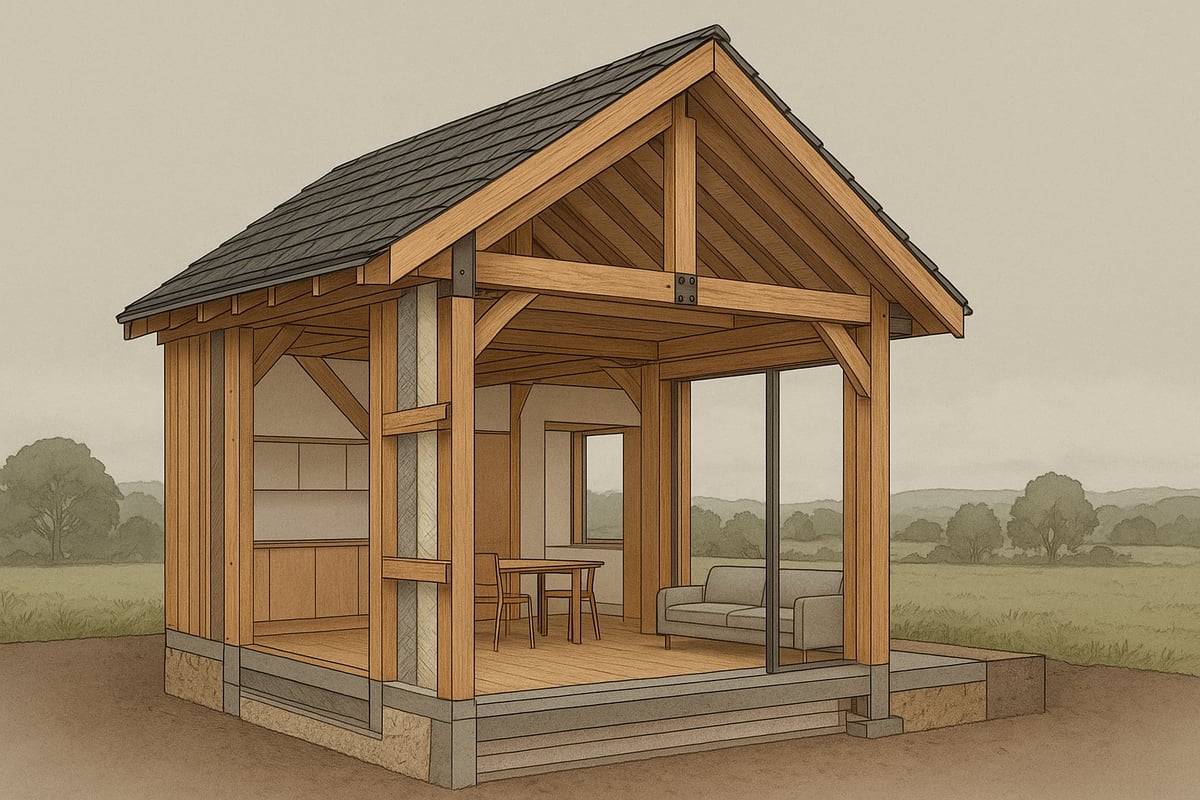
Timber Selection and Sustainable Sourcing
Choosing the right timber is the foundation of quality post and beam frame construction. In the UK, oak, Douglas fir, Alaskan Yellow Cedar, and Western Red Cedar are the most popular options. Oak stands out for its impressive durability, natural fire resistance, and potential to last up to 300 years.
Sourcing responsibly is crucial. Look for FSC-certified timbers to ensure forests are managed sustainably. The UK market is increasingly prioritising local and sustainably harvested wood, reducing transportation emissions and supporting ethical forestry. The quality of timber directly impacts both the structural integrity and the lifespan of the building.
For more on material selection and real-world examples, see Oak framed homes in the UK.
Metal Fasteners, Brackets, and Hybrid Systems
Modern post and beam frame construction relies on steel connectors, bolts, and brackets to join timbers efficiently. These metal components enable rapid assembly and boost the structure’s load-bearing capacity. Unlike traditional joinery, metal fasteners simplify connections and reduce the level of specialist skill required.
However, careful consideration must be given to corrosion risks. Using galvanised or stainless steel helps prevent rust, especially in humid or coastal regions. In 2025, innovations include fasteners designed for improved compatibility with both hardwood and softwood, as well as hybrid timber-steel frames that enhance structural performance. These hybrid systems combine the warmth of timber with the strength of steel, offering versatility for complex designs.
Design Flexibility and Customisation
One of the defining features of post and beam frame construction is its design flexibility. The method’s open framework allows for spacious, open-plan interiors with minimal load-bearing walls. This freedom supports a wide range of layouts for residential homes, barns, offices, and more.
Clients can customise their buildings by integrating materials such as glass or stone, creating unique visual statements. Exposed beams, vaulted ceilings, and large windows are popular design elements that maximise natural light and showcase the structure’s craftsmanship. Tailoring design to suit site conditions and personal preferences is straightforward, making each project distinctive.
Compliance with UK Building Regulations
Strict adherence to UK building regulations is essential in post and beam frame construction. Timber structures must meet standards for fire safety, insulation, and overall structural integrity. Regulations also govern aspects such as foundation depth, moisture protection, and environmental impact.
Obtaining planning permission often requires detailed documentation and professional input from architects and engineers. Fire-resistant treatments and high-quality insulation are standard requirements. Working with experienced professionals ensures compliance and helps navigate the complexities of UK codes, safeguarding the project from costly delays or non-compliance issues.
Energy Efficiency and Environmental Impact
Post and beam frame construction offers notable energy efficiency benefits. Timber’s natural insulating properties help reduce the need for artificial heating and cooling, supporting comfortable indoor environments year-round. When paired with modern insulation materials, these buildings can achieve excellent energy ratings.
Environmental impact is another major advantage. Timber is a renewable resource with a low embodied carbon footprint compared to concrete or steel. Lifecycle assessments show that sustainably sourced timber buildings contribute positively to carbon reduction targets. In 2025, the trend towards eco-friendly post and beam projects is accelerating, with more builders and homeowners seeking net-zero solutions and renewable energy integration.
Step-by-Step Guide to Post and Beam Construction
Embarking on a post and beam frame construction project requires a methodical approach. Each stage is essential for ensuring the structure’s strength, efficiency, and longevity. Below, we outline the core phases, from initial planning through to finishing details, to help you navigate your own build with confidence.
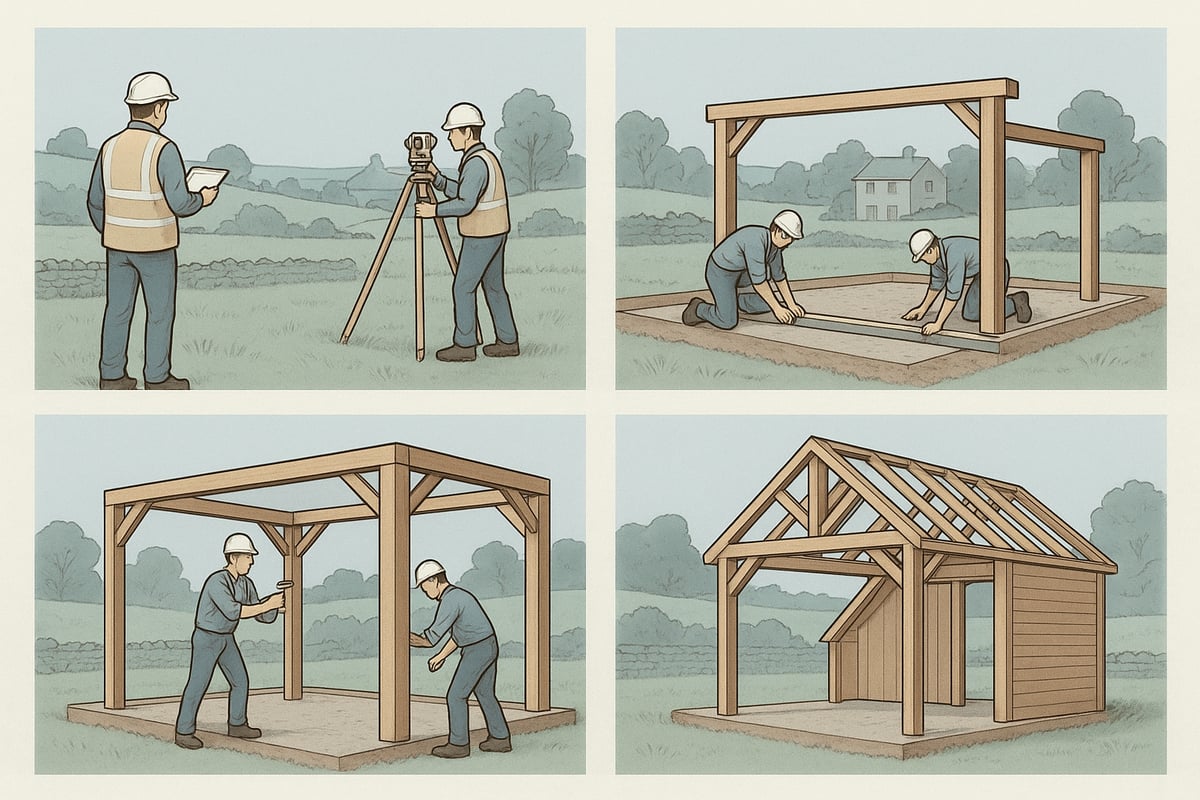
Pre-Construction Planning
Every successful post and beam frame construction begins with thorough planning. Start by assessing the site conditions, including soil type and drainage. This helps determine the right foundation and prevents future issues.
Set a clear budget and realistic timeline. Engage architects and structural engineers early, as their expertise is critical for developing precise plans. Secure all necessary planning permissions and building approvals, especially given the UK’s strict regulations.
Document every aspect of your project, from design choices to environmental considerations. This documentation streamlines communication between all parties and ensures smooth progress throughout the build.
Foundation and Groundwork
The foundation is the backbone of any post and beam frame construction. Common options include concrete slabs or pier foundations, chosen based on soil analysis and site topography.
Mark out the building footprint accurately. Prepare the ground by levelling and installing drainage solutions to protect against moisture. On sloped or uneven sites, pier systems can help maintain a level structure.
Allocate sufficient budget, as foundations typically account for 10–20% of total build costs. Investing in quality foundations prevents structural problems and supports the longevity of your post and beam frame construction.
Fabrication of Posts and Beams
Selecting the right timber is fundamental in post and beam frame construction. Choose species like oak or Douglas fir for durability and visual appeal. Timber must be properly graded and dried to prevent warping or splitting.
Modern workshops use CNC machinery for precision cutting, but traditional hand tools are still valued for bespoke work. Pre-drill holes for fasteners and connectors to maintain timber integrity.
Strict quality control ensures each post and beam meets structural requirements. Managing moisture content is crucial to avoid long-term movement or decay, safeguarding your investment.
Frame Assembly and Erection
With components ready, on-site assembly begins. Erect vertical posts first, securing them to the foundation. Horizontal beams are then lifted and aligned, forming the main structure of your post and beam frame construction.
Use metal fasteners, brackets, and bolts for strong, reliable joints. Temporary bracing keeps the frame stable during assembly. Adhering to safety protocols is essential, especially when handling heavy timbers.
A typical UK post and beam house frame can be assembled in a matter of days, highlighting the efficiency of this construction approach. For a full breakdown of this process, see the Frame home construction process.
Roof Structure and Decking
The next phase in post and beam frame construction is installing the roof system. Position roof beams, rafters, and trusses according to design specifications. Choose insulation and waterproofing layers suited to the local climate.
Decide between pitched, gabled, or flat roof styles, considering both aesthetics and function. Materials range from traditional clay tiles to modern metal sheets, each offering unique benefits.
Exposed roof structures not only add visual interest but also showcase the craftsmanship inherent in post and beam frame construction. Proper installation ensures weather resistance and long-term performance.
Wall Systems, Insulation, and Cladding
Walls in post and beam frame construction can be infilled with SIPs, timber panels, glass, or masonry. Selecting the right system impacts both energy efficiency and appearance.
Incorporate high-performance insulation to reduce heating and cooling needs. External cladding options include timber, render, or brick slips, each providing different textures and levels of weather protection.
Attention to detailing is vital to prevent moisture ingress and improve durability. The choice of wall system can significantly affect the building's overall energy performance and sustainability.
Finishing Touches and Internal Fit-Out
The final stage of post and beam frame construction focuses on transforming the shell into a comfortable space. Install windows, doors, and any internal walls according to your design.
Coordinate the integration of electrical, plumbing, and HVAC systems. Select finishes such as natural oils, stains, or paints to protect and enhance exposed timber features.
Custom joinery and architectural details can add character and value. Regular inspections and careful finishing ensure your post and beam frame construction remains beautiful and functional for years to come.
Benefits and Challenges of Post and Beam Construction
Post and beam frame construction offers a unique blend of architectural beauty, durability, and flexibility. However, like any building method, it comes with its own set of advantages and challenges. Understanding these can help you decide if this approach aligns with your project goals and long-term expectations.
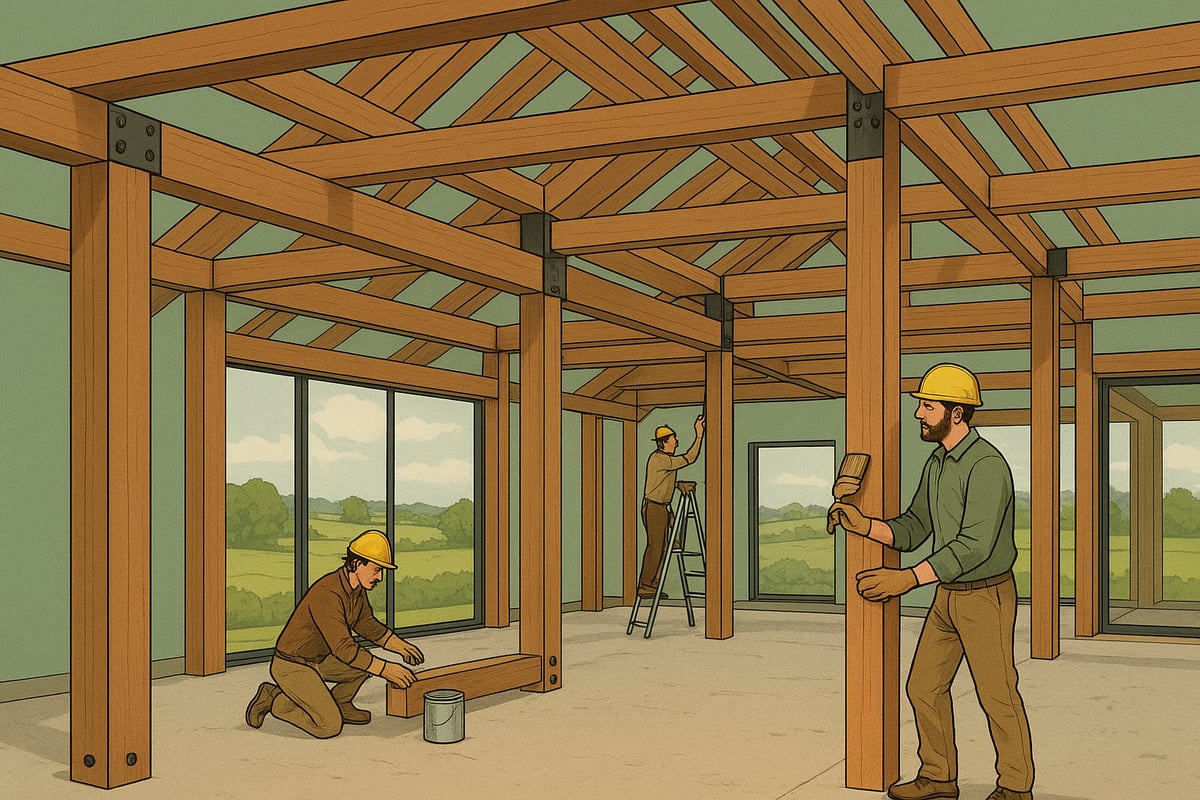
Key Advantages
Post and beam frame construction stands out for its structural strength and timeless appeal. The use of robust timbers such as oak or Douglas fir ensures stability and longevity, often exceeding 300 years with proper care.
- Rapid assembly due to prefabricated beams and posts
- Lower labour costs, as specialist joinery is not always required
- Flexible, open-plan layouts with minimal internal walls
The exposed timber elements create striking interiors and exteriors, appealing to those who value sustainable and eco-friendly homes. Energy efficiency is another benefit, as timber’s natural insulation helps reduce heating and cooling demands. For a deeper look at these benefits and design considerations, see this Post and beam construction explained resource.
Common Drawbacks and Mitigation Strategies
Despite the many positives, post and beam frame construction can be vulnerable to moisture and pests. Timber rot and steel corrosion are ongoing concerns, especially in the damp UK climate.
- Moisture protection: Use of breathable membranes and correct detailing
- Pest resistance: Regular inspections and pre-treatment of timber
- Maintenance: Scheduled cleaning and re-application of finishes
Assembly may take longer than conventional builds, especially if weather delays occur. Choosing quality materials and working with experienced craftsmen helps reduce long-term risks and ensures your structure remains sound for decades.
Cost Factors and Budgeting
The cost of post and beam frame construction is influenced by several variables. Material choice, customisation, and site conditions all play a role in the final budget.
| Factor | Typical Impact |
|---|---|
| Timber species | Oak is more expensive |
| Labour | Lower than timber frame |
| Design | Custom layouts cost more |
| Site access | Rural sites may cost more |
On average, expect to pay a premium over standard builds, but enjoy savings in labour and energy costs. Careful planning and competitive procurement can help you achieve a cost-effective project without compromising quality.
Longevity, Maintenance, and Value Retention
Post and beam frame construction is renowned for its durability. Oak frames, for example, have stood for centuries in the UK, requiring only routine inspection and minor repairs.
- Lifespan: Up to 300 years with proper maintenance
- Regular cleaning: Prevents decay and preserves appearance
- Insurance: Specialist cover may be needed for heritage structures
Properties built using this method often appreciate in value, thanks to their distinctive character and solid construction. Warranty options and insurance policies can further protect your investment.
Suitability for UK Climate and Lifestyle
The adaptability of post and beam frame construction makes it ideal for the UK’s diverse weather and landscape. Its thermal mass and insulation properties offer comfort in both rural and urban settings.
- Performs well in wind, rain, and snow
- Suits open countryside and city infill plots
- Acoustic benefits for peaceful living
Many homeowners appreciate the blend of traditional looks with modern living needs. Post and beam homes in the English countryside exemplify how this method aligns with evolving UK lifestyle trends.
Trends, Innovations, and Future Outlook
The landscape of post and beam frame construction is evolving rapidly in 2025. New technologies, design trends, and sustainability priorities are shaping the future of this time-honoured building method. By understanding where the industry is heading, readers can make more informed decisions for their own projects.
Emerging Technologies and Techniques
Innovations in post and beam frame construction are driving efficiency and precision. Prefabrication is now common, with large timber elements cut off-site using CNC machining. This approach reduces waste, speeds up assembly, and ensures a perfect fit on site.
Hybrid systems are becoming popular. Steel connectors and advanced timber treatments boost strength and longevity. Smart home integration is also on the rise, allowing for energy monitoring and automation.
Sustainable timber treatments developed in recent years extend the lifespan of wood without harsh chemicals. According to the Structural timber systems guide, these advancements lower maintenance demands and improve building performance.
Architectural Styles and Popular Designs
Design diversity is a hallmark of post and beam frame construction in 2025. Traditional barn and cottage styles are being revived, appealing to those who value heritage aesthetics. At the same time, minimalist and open-plan layouts are gaining traction among modern homeowners.
Mixing timber with glass and steel creates striking contemporary looks. Exposed beams, vaulted ceilings, and expansive windows are common features, blending rustic charm with modern comfort. The influence of UK architectural heritage remains strong, as seen in many countryside homes.
For inspiration and practical examples, the Post and beam home design resource offers insights into how design trends are being implemented across a variety of settings.
Sustainability and Net-Zero Construction
Sustainability is now central to post and beam frame construction. Timber’s ability to store carbon makes it a key player in reducing the built environment’s footprint. Many new builds follow passive house principles, with super-insulation, airtightness, and renewable energy systems.
Timber structures are also designed for recyclability at the end of their lifecycle. Government incentives and evolving UK policy are encouraging builders to adopt net-zero approaches. These changes are helping post and beam frame construction align with national climate targets.
Lifecycle analysis shows timber buildings outperforming many conventional methods in terms of embodied energy and operational emissions, making this method a top choice for eco-conscious clients.
Market Demand and Sector Growth
Demand for bespoke post and beam frame construction is rising. The self-build market is expanding as more people seek custom, sustainable homes. Commercial sectors, including offices, hospitality, and retail, are embracing timber for its flexibility and environmental credentials.
Economic and regulatory shifts are influencing growth, with forecasts indicating steady expansion through 2025 and beyond. The UK’s commitment to net zero is driving innovation and investment in this sector.
Adapting to changing lifestyles and climate needs, post and beam frame construction remains a future-proof choice for both residential and commercial projects.
Frequently Asked Questions About Post and Beam Frame Construction
Curious about post and beam frame construction? Below, we answer the most common questions to help you make informed decisions about your project.
What is the core principle of post and beam construction?
Post and beam frame construction uses a grid of vertical posts and horizontal beams to transfer building loads directly to the foundation. This structural logic allows for open interiors and fewer load-bearing walls, setting it apart from conventional methods.
What is the standard spacing for post and beam frames?
Spacing between posts in post and beam frame construction typically ranges from 23 to 47 inches. The exact distance depends on timber size, load requirements, and design preferences. Proper spacing ensures structural stability and maximises open-plan layout options.
How does wood joinery affect strength and longevity?
In post and beam frame construction, metal fasteners and brackets are used for joints, enabling quicker assembly and reliable strength. By contrast, traditional timber frame uses mortise and tenon joints, which require specialised skills but offer exceptional durability and a heritage finish.
What materials are best for post and beam structures?
Popular choices for post and beam frame construction include oak, Douglas fir, and cedar, combined with steel fasteners. For a detailed overview of materials and systems, see this Beginner’s guide to post and beam construction.
What are the main differences between post and beam and timber frame construction?
The main distinction is joinery: post and beam frame construction uses metal fasteners, while timber frame relies on intricate wood joinery. Post and beam is generally faster to assemble and requires less specialist carpentry.
How do post and beam buildings perform in UK weather?
Post and beam frame construction stands up well to rain, wind, and snow when built with quality timber and protected steel. Detailing such as overhangs and proper drainage further improves resilience in the varied UK climate.
Are post and beam homes energy efficient?
Yes, post and beam frame construction leverages wood’s natural insulation. With modern infill panels and airtight design, these buildings can outperform many conventional homes in terms of energy efficiency and comfort.
What maintenance is required for post and beam structures?
Routine maintenance for post and beam frame construction includes inspecting timber for moisture or pest damage, checking metal fasteners for corrosion, and applying finishes as needed. Regular care ensures long-lasting structural integrity and appearance.
If you’re feeling inspired by the beauty, strength, and sustainability of post and beam construction, you’re not alone. We’ve explored how modern design and traditional craftsmanship can come together to create bespoke spaces that stand the test of time—all while meeting today’s building standards and environmental goals. If you’re ready to turn your vision into reality or want tailored advice on your next project, I invite you to take the next step. Let’s create something exceptional together—discover how you can BUILD NOW with Acorn to Oak Framing.
